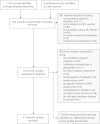Barriers and facilitators to HPV vaccination of young women in high-income countries: a qualitative systematic review and evidence synthesis
- PMID: 25004868
- PMCID: PMC4100058
- DOI: 10.1186/1471-2458-14-700
Barriers and facilitators to HPV vaccination of young women in high-income countries: a qualitative systematic review and evidence synthesis
Abstract
Background: Vaccination against Human Papillomavirus (HPV) is recommended for adolescent young women prior to sexual debut to reduce cervical cancer related mortality and morbidity. Understanding factors affecting decision-making of HPV vaccination of young women is important so that effective interventions can be developed which address barriers to uptake in population groups less likely to receive the HPV vaccine.
Methods: We undertook a qualitative systematic review and evidence synthesis to examine decision-making relating to the HPV vaccination of young women in high-income countries. A comprehensive search of databases from inception to March 2012 was undertaken to identify eligible studies reporting the perspectives of key stakeholders including policy makers, professionals involved in programme, parents, and young women. Factors affecting uptake of the vaccine were examined at different levels of the socio-ecological model (policy, community, organisational, interpersonal and intrapersonal).
Results: Forty-one studies were included. Whether young women receive the HPV vaccine is strongly governed by the decisions of policy makers, healthcare professionals, and parents. These decisions are shaped by: financial considerations; social norms and values relating to sexual activity, and; trust in vaccination programmes and healthcare providers. Financial constraints may be overcome through universal healthcare systems offering the HPV vaccine free at the point of delivery. In the healthcare setting, judgements by healthcare professionals about whether to recommend the vaccine may restrict a young woman's access to the vaccine irrespective of her own beliefs and preferences. Parents may decide not to allow their daughters to be vaccinated, based on cultural or religious perceptions about sexual activity.
Conclusions: Barriers to the uptake of the HPV vaccine have implications for young women's future sexual, physical and reproductive health. Interventions to address barriers to uptake of the vaccine should target appropriate, and multiple, levels of the socio-ecological model. Issues of trust require clear, accessible, and sometimes culturally appropriate, information about the HPV vaccination programme. Although young women are central to the HPV vaccination programme, their views are underrepresented in the qualitative literature. Future research should consider young women's perceptions of, and involvement in, consent and decision-making.
Figures
Similar articles
-
Factors that influence caregivers' and adolescents' views and practices regarding human papillomavirus (HPV) vaccination for adolescents: a qualitative evidence synthesis.Cochrane Database Syst Rev. 2025 Apr 15;4(4):CD013430. doi: 10.1002/14651858.CD013430.pub2. Cochrane Database Syst Rev. 2025. PMID: 40232221 Free PMC article.
-
Drivers of human papillomavirus vaccine uptake in migrant populations and interventions to improve coverage: a systematic review and meta-analysis.Lancet Public Health. 2025 Aug;10(8):e693-e711. doi: 10.1016/S2468-2667(25)00148-3. Lancet Public Health. 2025. PMID: 40738554
-
Parents' and informal caregivers' views and experiences of communication about routine childhood vaccination: a synthesis of qualitative evidence.Cochrane Database Syst Rev. 2017 Feb 7;2(2):CD011787. doi: 10.1002/14651858.CD011787.pub2. Cochrane Database Syst Rev. 2017. PMID: 28169420 Free PMC article.
-
Factors that influence parents' and informal caregivers' views and practices regarding routine childhood vaccination: a qualitative evidence synthesis.Cochrane Database Syst Rev. 2021 Oct 27;10(10):CD013265. doi: 10.1002/14651858.CD013265.pub2. Cochrane Database Syst Rev. 2021. PMID: 34706066 Free PMC article.
-
Prophylactic vaccination against human papillomaviruses to prevent cervical cancer and its precursors.Cochrane Database Syst Rev. 2018 May 9;5(5):CD009069. doi: 10.1002/14651858.CD009069.pub3. Cochrane Database Syst Rev. 2018. PMID: 29740819 Free PMC article.
Cited by
-
Factors associated with adolescent HPV vaccination in the U.S.: A systematic review of reviews and multilevel framework to inform intervention development.Prev Med. 2020 Feb;131:105968. doi: 10.1016/j.ypmed.2019.105968. Epub 2019 Dec 24. Prev Med. 2020. PMID: 31881235 Free PMC article.
-
Knowledge, attitudes, and practices towards HPV vaccination among reproductive age women in a HIV hotspot in the US.PLoS One. 2023 Jan 19;18(1):e0275141. doi: 10.1371/journal.pone.0275141. eCollection 2023. PLoS One. 2023. PMID: 36656804 Free PMC article.
-
Low attendance by non-native women to human papillomavirus vaccination and cervical cancer screening - A Danish nationwide register-based cohort study.Prev Med Rep. 2020 Apr 28;19:101106. doi: 10.1016/j.pmedr.2020.101106. eCollection 2020 Sep. Prev Med Rep. 2020. PMID: 32426214 Free PMC article.
-
Human Papillomavirus vaccination in general practice in France, three years after the implementation of a targeted vaccine recommendation based on age and sexual history.Hum Vaccin Immunother. 2016;12(2):528-33. doi: 10.1080/21645515.2015.1078042. Hum Vaccin Immunother. 2016. PMID: 26309144 Free PMC article.
-
"We will do whatever it takes": Understanding Socioecological Level Influences on Hmong-American Adolescents and Parents' Perceptions of the Human Papillomavirus Vaccine.J Cancer Educ. 2022 Dec;37(6):1893-1901. doi: 10.1007/s13187-021-02057-4. Epub 2021 Jun 23. J Cancer Educ. 2022. PMID: 34164765 Free PMC article.
References
-
- World Health Organisation. Human papillomavirus vaccines. WHO position paper. Wkly Epidemiol Rec. 2009;84:118–131. - PubMed
-
- Koulova A, Tsui J, Irwin K, Van Damme P, Biellik R, Aguado MT. Country recommendations on the inclusion of HPV vaccines in national immunization programmes among high-income countries, June 2006–January 2008. Vaccine. 2008;26(51):6529–6541. - PubMed
-
- UN General Assembly. Convention on the Rights of the Child. United Nations, Treaty Ser. 1989;1577:3.
-
- Sinka K, Kavanagh K, Gordon R, Love J, Potts A, Donaghy M, Robertson C. Achieving high and equitable coverage of adolescent HPV vaccine in Scotland. J Epidemiol Community Health. 2013;68(1):57–63. - PubMed
Publication types
MeSH terms
Substances
Grants and funding
LinkOut - more resources
Full Text Sources
Other Literature Sources
Medical



